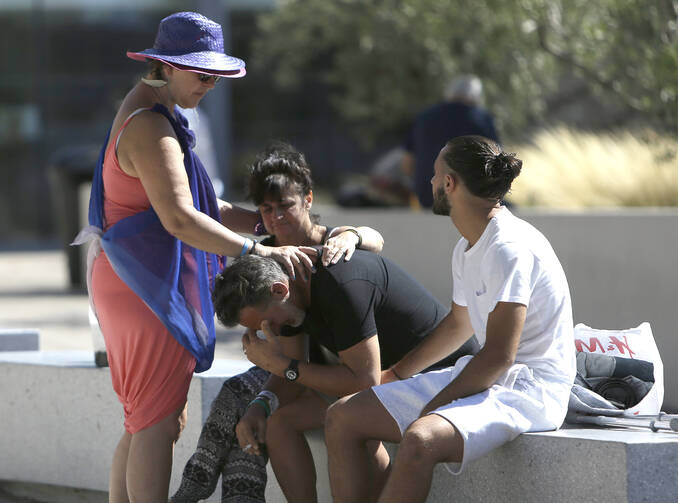Tighter Western security measures and immigration controls are two likely outcomes of last night’s truck attack in France, but a closer appraisal of “crisis architecture” may be another response to the unprecedented attack. More than 80 have been killed and many left seriously injured after Tunisian-born Mohamed Lahouaiej Bouhlel plowed a 20-ton refrigerated truck through two kilometers of people on a crowded promenade. His victims had been peacefully celebrating Bastille Day in Nice on July 14.
“These types of attacks are not going away,” said Daveed Gartenstein-Ross, a senior fellow at the Foundation for Defense of Democracies and adjunct assistant professor in Georgetown University’s security studies program. “They are going to get worse before they get better.”
“One thing we should be thinking about is what I call crisis architecture,” Gartenstein-Ross said. He explained that what “a lot of mass casualty attacks have in common is an architecture, either an internal architecture in a building or an outdoor architecture, that makes it easier for attackers to kill a large number of people.” He cited the assaults on two night clubs, one in Orlando, Fla., and the other in Paris, France, that left scores dead as examples of an architecture that packed people into tight areas with few opportunities to escape and “not a lot of barriers to a shooter who was trying to move through the area.”
He said, “Similarly, in this case you have an attacker who literally was able to drive for 2 kilometers hitting people all the way; he did not run into a spike strip; he did not run into a barrier that was designed to slow down or stop a vehicle.” Despite the fact that al Qaeda had already suggested an interest in a “ramming attack” at the event, “the architecture was not designed to slow down any attacker who was trying to drive and run people down.” Why those measures were not put in place beforehand should be a focal point of the investigation into the attack.
“I think that, sadly, we’re at a place where, not just for terrorism reasons but for a wide variety of reasons, we need to think about crisis architecture which can limit the amount of casualties,” Gartenstein-Ross said. “These attacks are going to get worse before they get better; that’s why it’s important to think about how we mitigate the impact and save lives, knowing that these things are going to continue.”
Gartenstein-Ross cautioned against coming to any quick conclusions about the truck attacker, whether he acted alone or was part of a terrorist network or was inspired to the attack by extremist propaganda. He worried over a too-hasty narrative “solidifying” that might discourage investigators from fully exploring all aspects of the incident. That has, according to Gartenstein-Ross, led to significant intelligence failures after recent attacks in Paris and Brussels.
Talk of a response by France against ISIS has followed quickly in the aftermath of the attack. What may seem like a mere retaliation could, all the same, be effective in preventing more terror attacks, according to Gartenstein-Ross. “Having a caliphate in place, having this quasi state in place where attackers can plan and train for future attacks does make this organization more deadly.”
ISIS capability in Europe was evident in the attacks in Brussels and Paris, he said.
“The ISIS caliphate is an extraordinarily brutal thing; they take sex slaves and boast about it openly; they behead people; they are a genocidal organization.
“I think it’s hard to disagree with France’s decision to ramp up operations against ISIS even apart form this particular attack [since] they’ve carried out multiple attacks throughout the world,” most recently in the Muslim world itself at the end of Ramadan.
He adds, “There are multiple reasons to want to see this very brutal extremist organization collapse much more quickly.”
ISIS as a caliphate “is in very clear decline right now,” he said. “They’ve been losing territory quite rapidly and losing it on both sides of their caliphate, both on the Iraq side and in Syria.” The United States has been taking a piecemeal approach to eliminating ISIS. Gartenstein-Ross believes these continuing attacks may lead to a more forceful campaign against ISIS in Syria and Iraq, perhaps coordinated with whatever French response is forthcoming.
He also believes that a more cautious approach to immigration from extremist hotspots such as Syria and Iraq are justified. “Europe’s policies have been extraordinarily irresponsible” so far on the Middle East migration crisis, he argues.
“Clearly mass migration into Europe is making things more dangerous,” he said. European intelligence and security agencies have been “asleep at the switch” and have to learn to be “nimble” in response to a fast-evolving threat. He suggests that more intelligence and security resources should be devoted to border control, screening migrants passing through the by now well-established routes out of the Middle East and into Europe.
The need for better security strategy, he said, has to be separated from compassion for the people of the region who seek to escape the same ISIS terror. As much as the suffering of many of ISIS’s regional victims has to be acknowledged, ultimately, “Europe has an obligation to look out for its citizens,” he said. “This is a route that has been used to move terrorists into Europe—full stop. It is very important to try to safeguard European citizens….
“These are difficult policy steps,” he adds, but in the end “in any society one of its first obligations should be to take care of its own citizens.” Refugees could be contained until security risks are better assessed, he suggests. Too few such assessments are made now before migrants enter the European Union and become difficult to track.
Describing the migration crisis as “utterly mishandled” by European powers, Gartenstein-Ross said, “[European states] need to absolutely prioritize keeping their people safe. Those are their people; they need to protect their people.”
Listen to the complete interview.








